A 2-day Valencia itinerary should be just enough to understand why Valencia is described as a “city of contrasts.” On the one hand, the city boasts some of the finest medieval architecture in Spain. But it is also home to world-renown contemporary architecture.
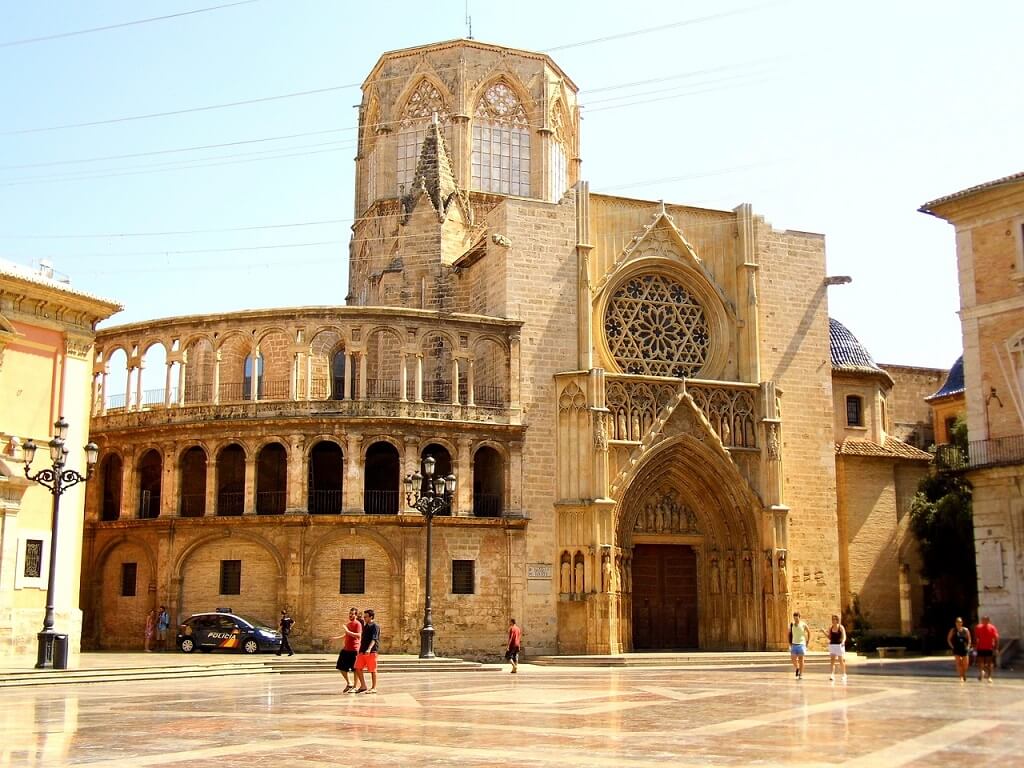
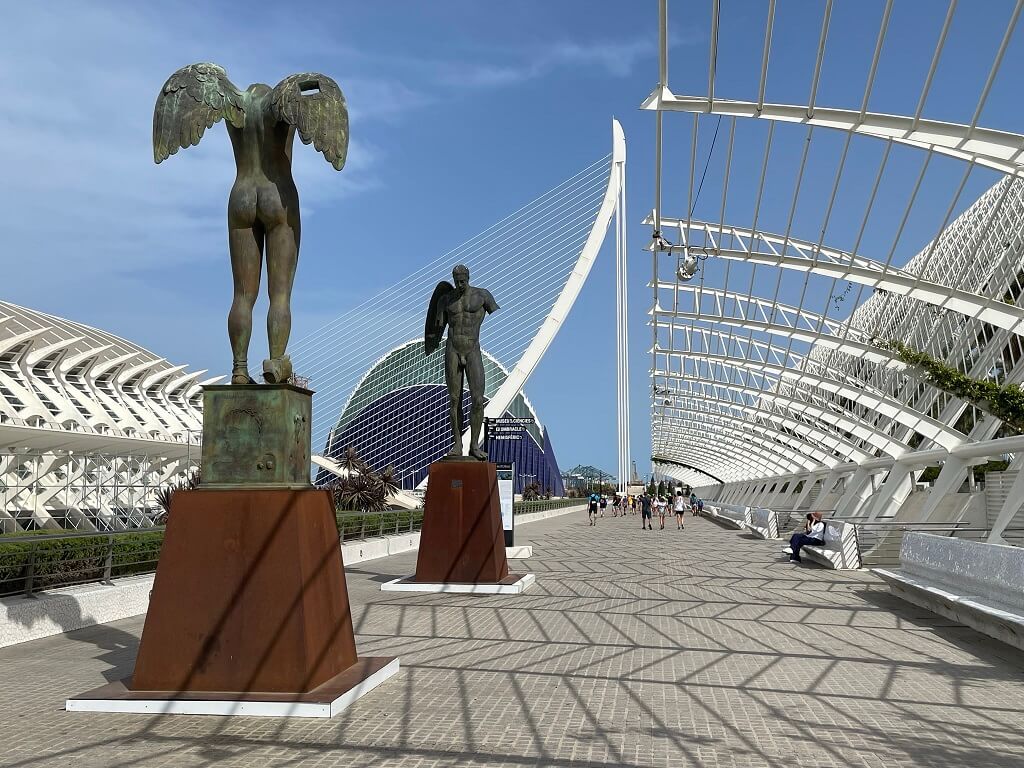
Table of Contents
ToggleThis 2-day Valencia itinerary aims to share the sights and experiences I encountered in Spain’s third largest city, after Madrid and Barcelona, and certainly one of its most interesting. Valencia is also the capital of its eponymous autonomous region where the Valencian language, Valencià, is spoken.
I found Valencia to be cosmopolitan, historical, beautiful and grossly underrated. Read on to see why.
What is Valencia known for?
The most striking feature of Valencia would have to be the stunning architecture. On the cuisine front, Valencia is the undisputed origin of the famous, delectable rice dish, the paella Valenciana. Valencia is also known for horchata, a milk-like drink made from almonds, Valencia oranges and unique festivals like the Fallas Valencianas. These festivals are celebrated with the coming of spring by burning spectacularly ornate paper mâché figurines.
A short history of Valencia
The city started its life as a Roman settlement founded in 138 BCE when it was known as Valentia, meaning “strength” or “fortitude.” During its Roman heyday Valencia was one of the most important Roman settlements in Spain. That’s really saying something because Spain was one of the major centers of the Roman Empire.
The Moors arrived in 718 CE ushering 5 centuries of Islamic culture until reconquered by the Spaniards in 1238.
In the 15th century the city flourished as a center of economic expansion, art and culture. It became a silk trading center as well as an important port.
The city suffered attacks from Barbary pirates in the 16th century and was subsequently fortified with structures you can still see today. Subsequent invasions, sieges and assaults impeded the city’s growth and development until a period of stability arrived with the reign of Isabela II (1833-1868).
World War I disrupted the city’s critical citrus market which negatively affected the city’s entire economy. The Spanish Civil War (1936-1939) left many “Valencianos” dead as the city suffered over 442 bombardments.
A major flood of the Turia River in 1957 caused tremendous upheaval and destruction to the city. As a result, the river was rerouted. A lush and beautifully manicured park was created on the former riverbed which today winds its way around the city.
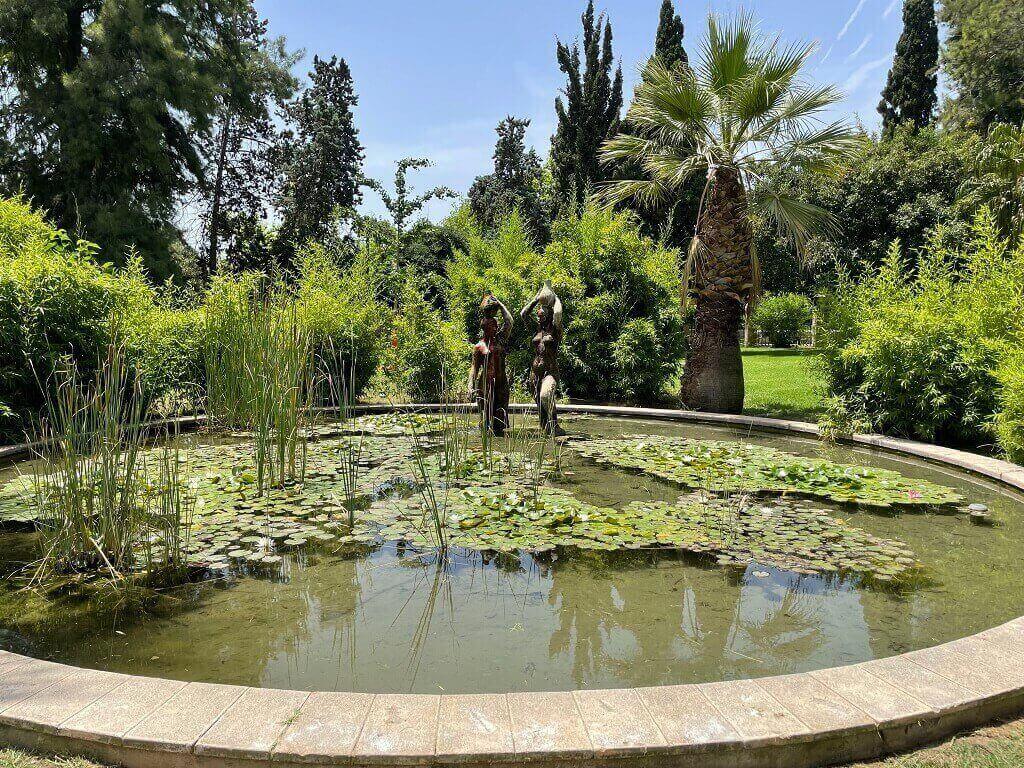
The city began to recover in the 1960s with increased immigration led by infrastructure projects. The advent of democracy after the fall of dictator, Generalissimo Francisco Franco, established Valencia as an autonomous region.
In 2009 Valencia was selected as the 29th fastest developing city in Europe and it hasn’t looked back since.
A 2-day Valencia itinerary – Old Town
Valencia Old Town-Day 1 of your 2-day Valencia itinerary
A 2,000-year-old-city is bound to have an abundance of interesting historical attractions. Valencia’s Old Town is no exception. The area reflects the city’s heritage and retains its original medieval layout as evidenced by the 12th century Torre Serrano (Serrano Towers) guarding one of the medieval gates to the city.
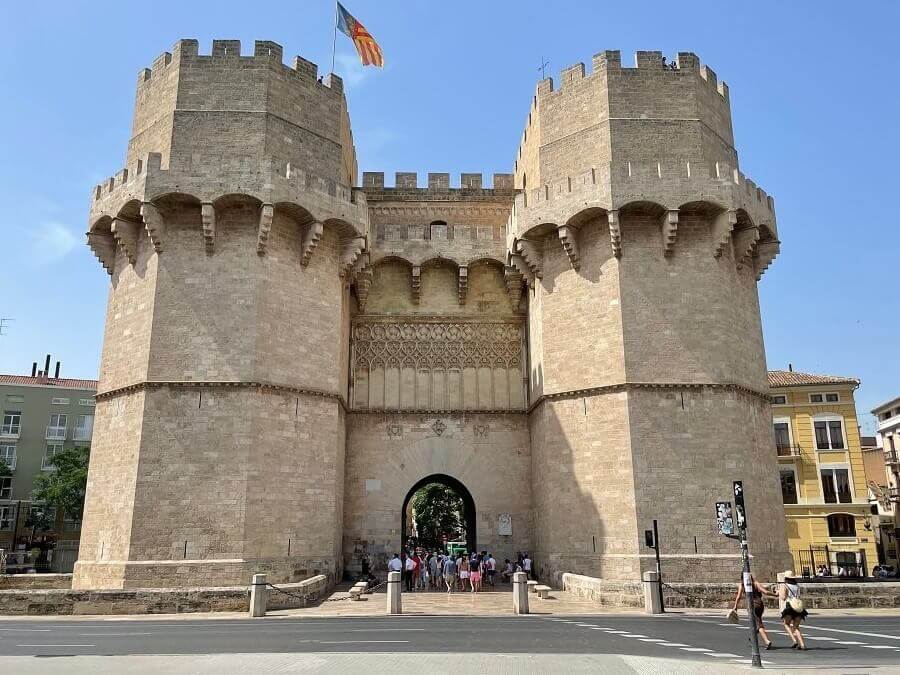
But for sheer aesthetic and historical appeal, you can’t beat the classic Old Town trio; the Silk Exchange, a UNESCO World Heritage Site, the Valencia Cathedral and the Central Market with its striking Art Nouveau design.
Everything in Valencia’s Old Town is easily walkable but the winding streets and alleyways can be a navigational challenge. Get lost in them!
The Valencia Cathedral
Although officially named the Metropolitan Cathedral-Basilica of the Assumption of Our Lady of Valencia, the locals just call it the Valencia Cathedral.
Begun in 1262 but not completed until almost 200 years later, the cathedral continued to add on improvements for hundreds of years. In fact, a building was added as late as 1970!
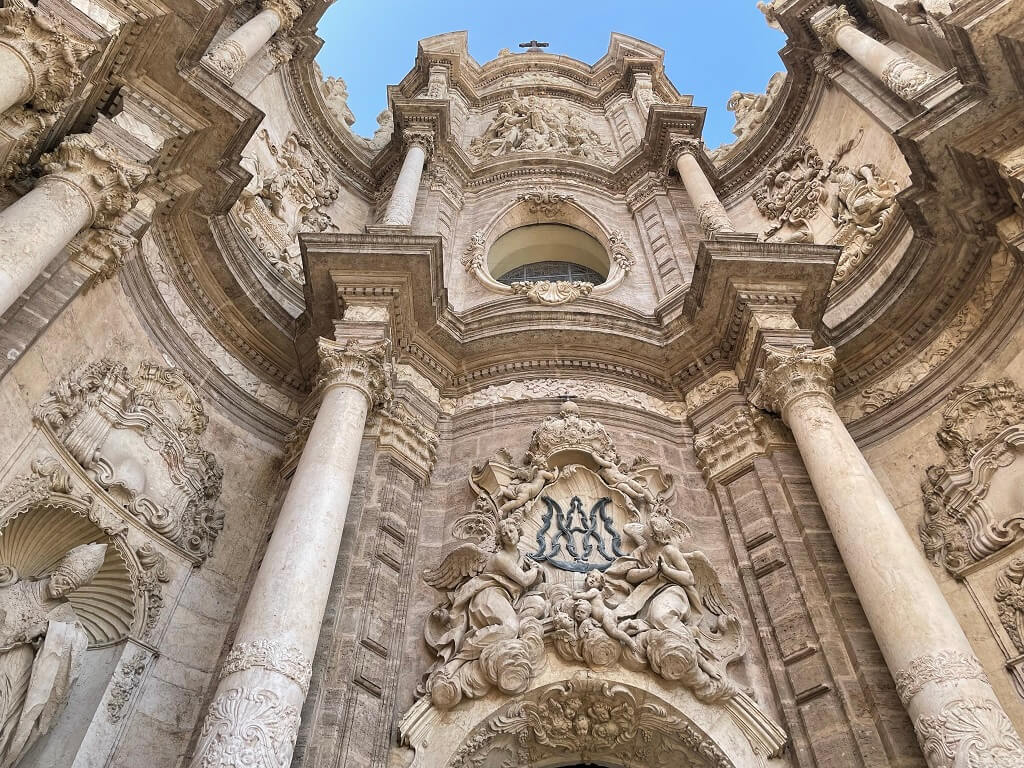
Of course, with all these additions over the years, the cathedral exhibits many architectural styles; Romanesque, Baroque, Renaissance and more. Inside there are paintings by accomplished Spanish artists dating from the 15th century.
Besides being beautiful inside and out, the cathedral has an important claim to fame. Many believe that the cathedral houses the true Holy Grail, a relic sacred to Christians. You can see it at the chapel of the Holy Chalice inside.
Plaza de la Reina (Queen Square)
One of the oldest plazas in the city, Plaza de la Reina began construction in honor of Queen Maria de La Merced on her wedding day to King Alfonso XII in 1878.
This plaza is one of the coolest places to visit in Valencia. It is surrounded by cafes, restaurants, cute little shops and amazing architecture not the least of which is the cathedral of Valencia.
A short walk away are the Silk Exchange and the Central Market, two of the must-see sights in Valencia.
Stop and enjoy a coffee or an authentic horchata in this lovely plaza before continuing on to your next Valencia attraction.
Iglesia y Torre de Santa Catalina (Santa Catalina Tower and Church)
For the architecture aficionados, head to La Paz Street near Queen Square to see the Baroque bell towers of the Santa Catalina church. Inside you’ll see some of the best examples of religious art in Valencia.
Casa Francisco Ordeig (Francisco Ordeig House)
Barcelona has its architecturally significant Casa Batllo, but Valencia has its Casa Francisco Ordeig. It is a residential apartment building built in the modernist style in 1907 and considered an architectural work of art.
Mercado Central (Central Market)
One of the largest markets in Europe, the Mercado Central is another must-visit Valencia attraction and should be included in every 2-day Valencia itinerary. The market used to be an open-air affair until the city put out a bid so architects could submit their concepts for a new market in 1910.
Architects March and Vidal won the bid and completed the market in the Art Nouveau style in 1928.
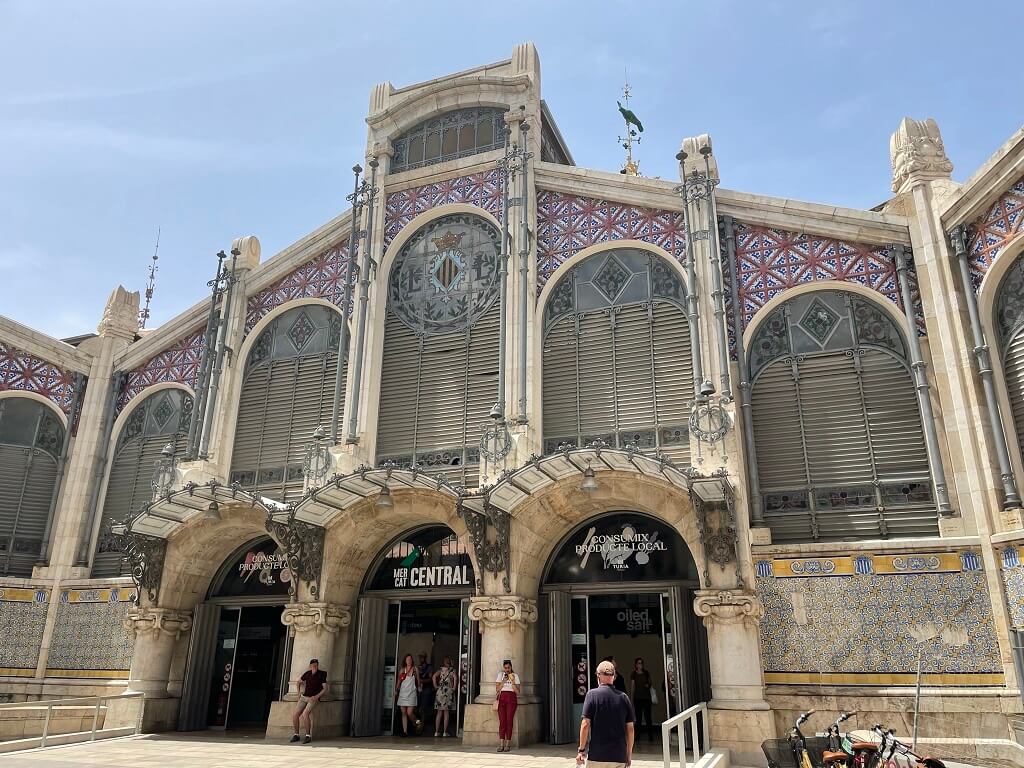
Today the market is a popular destination for tourists as well as local with its restaurants, souvenirs and cafes.
Make time for a snack at this Mercado Central for an authentic and tasty experience.
Valencia tip: The hours are Monday to Saturday 8 AM to 2:30 PM so time your visit to enjoy your visit. There is much to see.
The Silk Exchange
Right across the street from the Mercado Central is the Silk Exchange. There is a reason why this is a UNESCO World Heritage site. This uplifting, glorious structure deserves every accolade the artistic and historical world can bestow upon it.
Valencia was a major trading center for centuries and this Valencia Gothic structure was at the center of it. The exchange has three sectors: the main hall, the contract hall (where the trading took place) and the pavilion of the consulate. There is also a lovely orange grove garden in a walled courtyard.
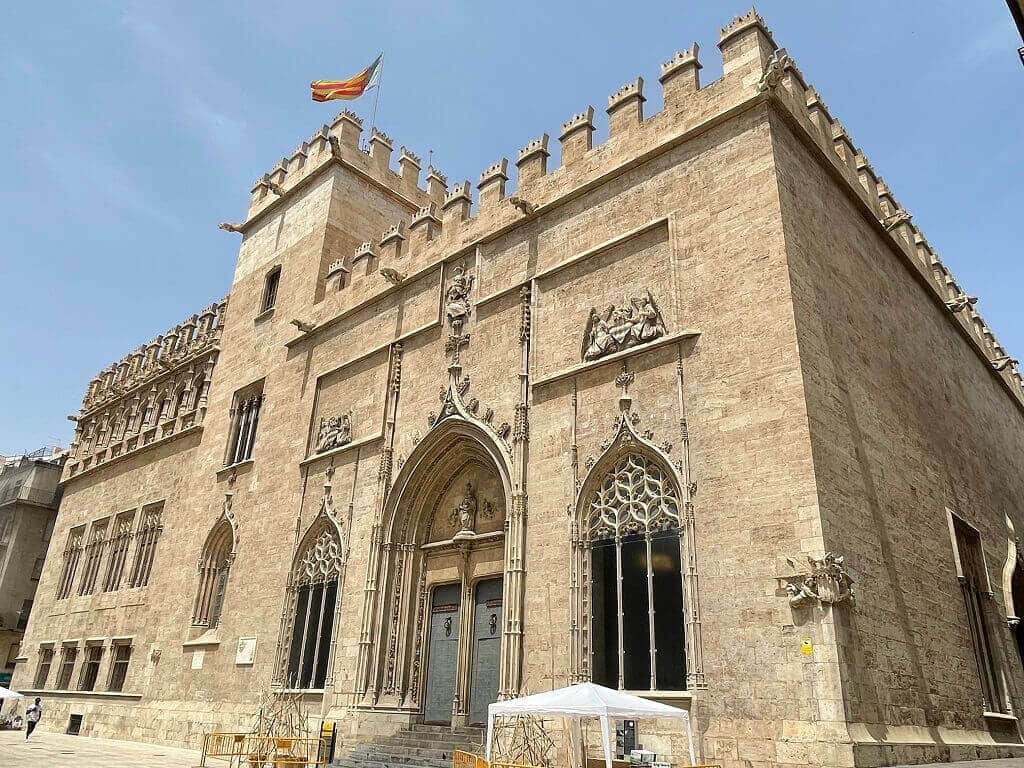
The furnishings are the originals for the period and lend an air of authenticity and historical significance to the Exchange.
The Silk Exchange is such a fascinating place. I don’t know what I liked the most about it, the historical significance or the sheer beauty of the architecture.
Valencia tip: Whether or not you’re a history buff, get the free audio tour for the Silk Exchange. You’ll learn about the significance of the gothic gargoyles and elaborate caricatures that decorate this building among other fascinating historical tidbits.
Basilica de Nuestra Señora de los Desamaparados (Basilica of Our Lady of the Forsaken)
Dedicated to the patron saint of Valencia, the basilica dates from the 17th century and was one of the first Baroque structures of the time. The basilica boasts an impressive, beautifully decorated dome.
There is a very small museum located behind the basilica of the Virgin. It was built over an existing Roman archeological site. The “display”, located below street level, are the actual Roman-period (and later) ruins/site of the city of Valencia.
One can see the first Roman roads built by the first settlers of Valencia. Instead of walking from one display cabinet to another, one walks through the actual ancient city, moving from one ancient structure (e.g., village granary, bath, roads, town hall, etc) to another that have been unearthed and left right where they were found.
Additional churches of Valencia’s Old Town
I addition to those already mentioned, there are a number of lesser churches worth visiting in Valencia’s Old Town if you have the time and interest.
- Parroquia de San Nicolas de Bari y San Pedro Martir (Church of Saint Nicholas)
- Iglesia de San Lorenzo (San Lorenzo Church)
- Iglesia de San Juan del Hospital (San Juan Church)
- Iglesia de Santo Tomas y San Felipe Neri (Church of Saints Tomas and Philip
Plaza del Ayuntamiento (City Hall Plaza)
The plaza is the heart of the Old Town, akin to a “Times Square” of Valencia. It is pedestrianized with performers dressed as cartoon characters offering photo opportunities for tips.
This wide, gracious plaza is surrounded by gloriously ornate 19th century buildings in blazingly white marble and stucco. The entrance to the plaza is a last stop for many buses because they cannot continue into the pedestrianized Old Town.
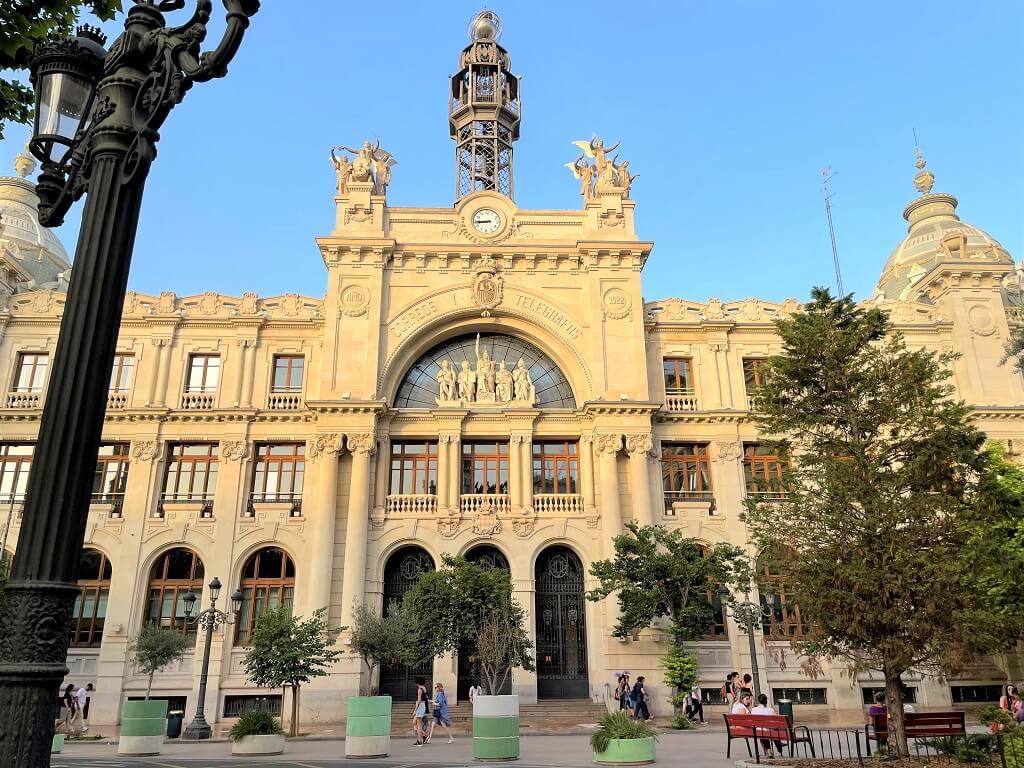
Many government buildings and high-end hotels are located here. The center is a lovely park with flower shops and many smart shops, cafes and tourist souvenirs lining the perimeter.
Here is where you’ll find the main tourism office where you can get free information and maps. You can also buy tickets to many attractions here.
Valencia Museums
Museo de la Historia de Valencia (Museum of the History of Valencia)
For a city with a history dating back for millennia, Valencia has lots to say. One of the most interesting aspects of this museum is the industrial architecture.
The museum showcases the important events that forged the history of the region. Well worth your time to better understand the city.
Museo Nacional de Ceramicas y Artes Decorativos (Museum of Ceramics and Decorative Arts)
I fell in love with this wonderful place. This museum is badly named. Yes, it has SOME ceramics, but it is really all about the former home of the Marquis of Dos Aguas. And what a home it was!
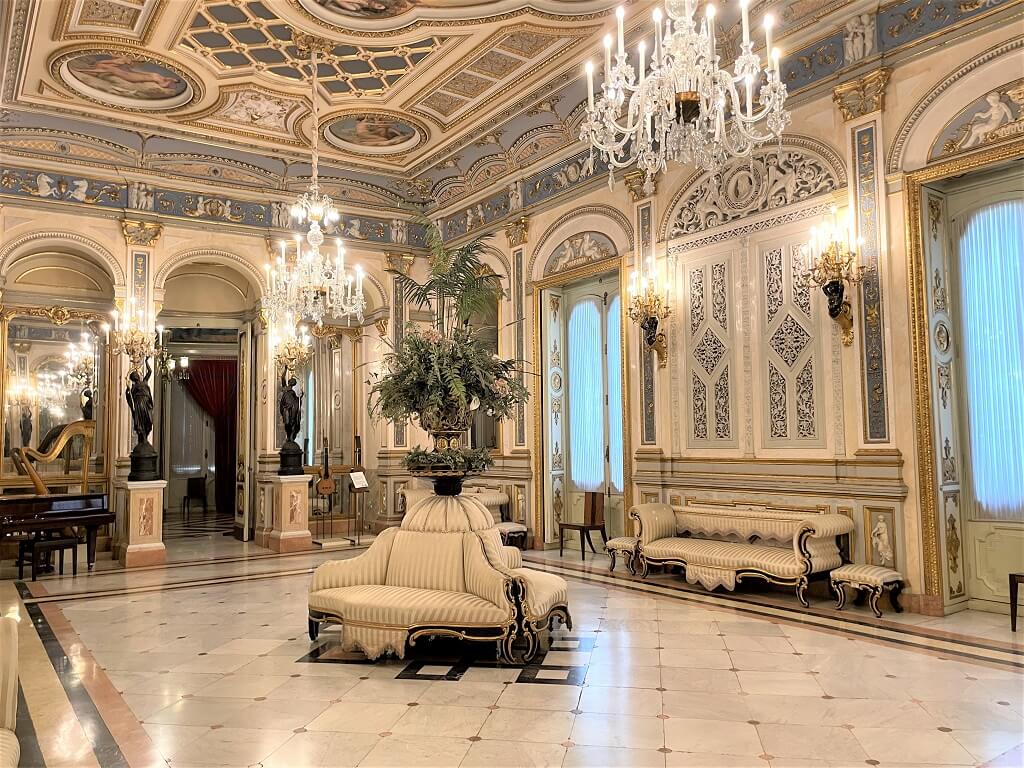
The ballroom opened out to a balcony facing a beautiful town square.
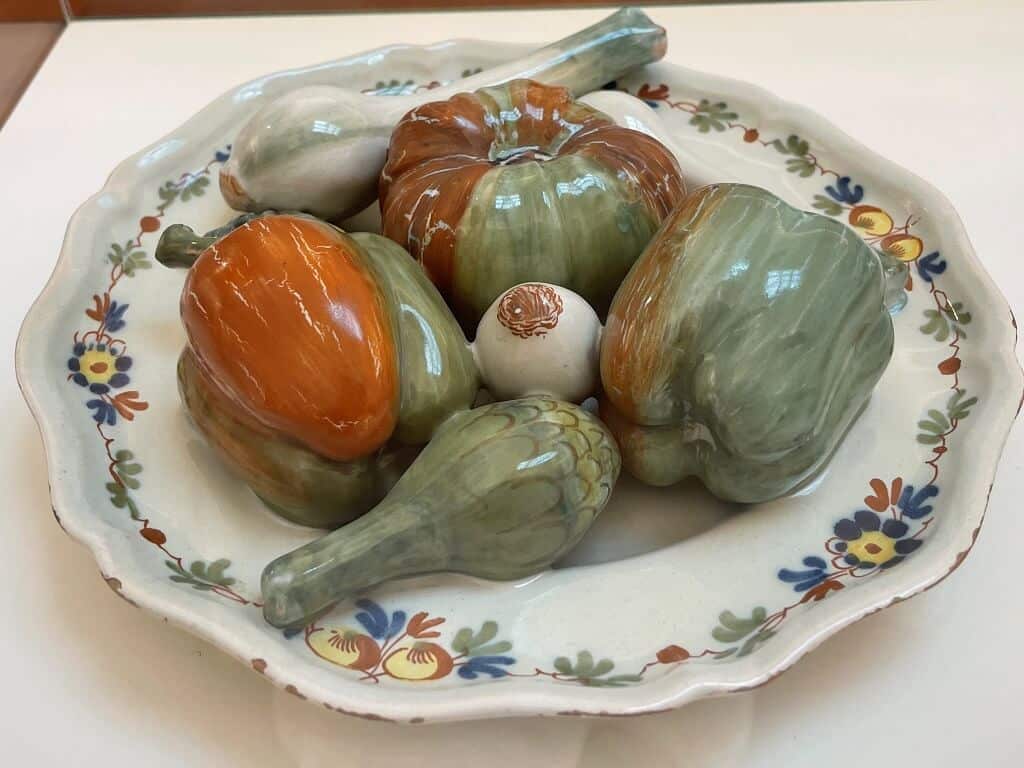
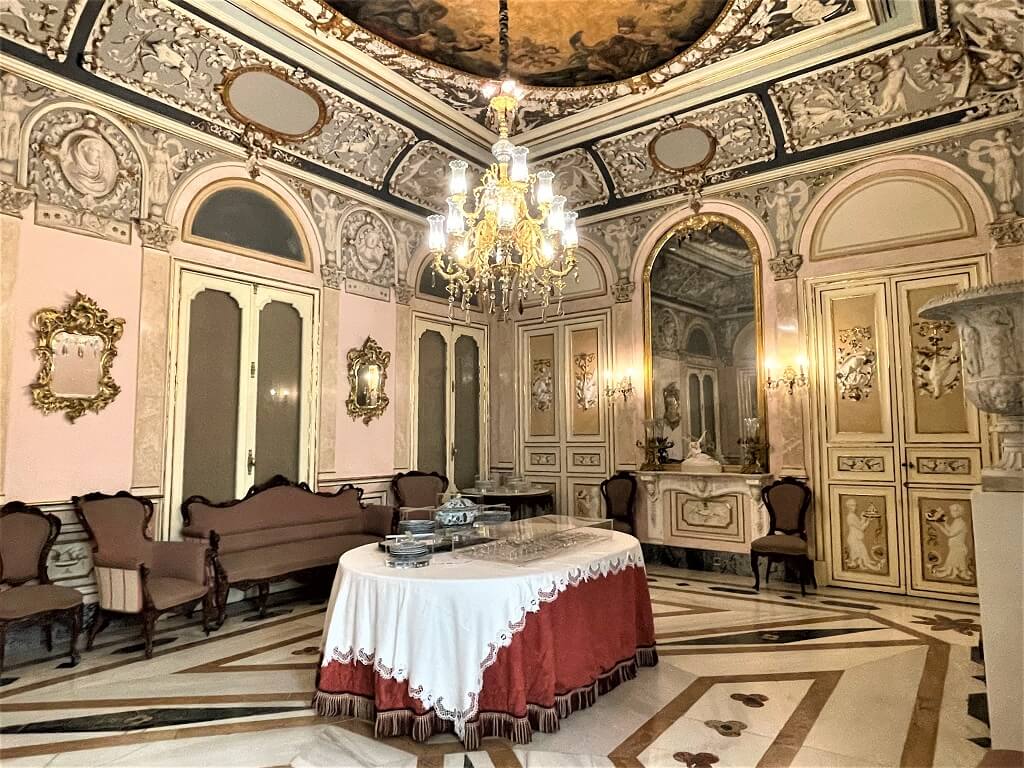
Room after room of sumptuous decorative arts are on display in this marvelous mansion. Similar to the Newport Mansions of Rhode Island, The Biltmore Estate of North Carolina, USA or the many museum mansions of Europe, this remarkable museum offers a glimpse of what life was like for the massively wealthy classes.
This museum is a perfect example of the little gems you find in unexpected places. It was one of the most pleasant museum surprises I’ve ever encountered. THIS is why you travel!
Museo Fallero (Fallas Museum)
Stop #3 on the Hop-On-Hop-Off red line bus, this small but fun museum displays the paper mâché figurines, known as “ninots” that are burned every year as a symbol of the coming of spring in traditional celebrations.

The figurines started off as scarecrow stick figures stuffed with hay and decorated with old clothes. Today, some of these decorations are worth tens of thousands of euros and are works of art.
Museo Historico Militar (Historical Military Museum)
For the military history buff. Stop #11 on the Hop-On-Hop-Off red line bus, the Military History Museum, details many important events in the city’s military history including its participation in the Spanish Civil War.
Museo de Bellas Artes de Valencia (Museum of Fine Arts of Valencia)
Widely recognized as one of the finest collections of Spanish art in the world and second only to Museo El Prado in Madrid, this museum really packs an artistic punch.
The museum has been recently renovated and is housed in what was once a convent, hospital and headquarters for the Spanish government of the II Republic during the Spanish Civil War.
Don’t miss the collection of home-town-boy-done good, Joaquin Sorolla, and his glorious paintings of the Valencian countryside. If you’re a culture vulture, this is for you.
Turia River Gardens
As mentioned in the Valencia history section, the city suffered major floods throughout its history. On October 15, 1957, when the Turia River again overflowed, the city had enough. It was the most devastating disaster Valencia experienced since the Spanish Civil War.
The city successfully diverted the river which resulted in an empty riverbed snaking its way across the city from southeast to northwest. This reverbed was landscaped and populated with little cafes, gardens, street art and delightful little bike and walking trails. You can now walk from one side of the city to another via the Turia River gardens and in the process learn about the city.
As the Turia River Gardens snakes its way throughout the entire city, it will be easy to incorporate a stroll in one of its gardens into your 2-say Valencia itinerary.
Day trips from Valencia
Las Arenas
Las Arenas (the sands) is part of Valencia proper. It is the beach area on the far eastern side of the city. Las Arenas is accessible by local transport and is a stop on the Hop-On-Hop-Off tourist bus.
The beach is wide with calm waters and ringed by surprisingly good restaurants and upscale hotels and spas. One of Valencia’s top restaurants, La Pepica, is in Las Arenas.
L’Albufera de Valencia
About 20 minutes south of Valencia is the Albufera de Valencia National Park. This beautiful fresh-water lagoon is a haven for over 300 bird species.
The national park makes for a great day trip to enjoy the area’s nature at its best. Bike the 78-kilometer circular route through forests and rice paddies or take a boat ride and explore the area close up.
After exploring the park, have an authentic paella in the very spot this iconic dish was invented. The town of El Palmar claims to be the inventor of the paella. The town hosts several restaurants on its main street, Arroceria Mirabel being one of the most popular.
To get to L’Albufera de Valencia take city bus # 24 and 25 from the center of Valencia to El Palmar €1.50 each way.
Another option is to buy a tour to L’Albufera which includes a boat ride. These can be purchased wherever you buy Hop-On-Hop-Off tickets.
How to get around in Valencia
Walk
Valencia is an eminently walkable city. It is compact and pleasant to stroll.
Bike
There are bike rental stations throughout the city.
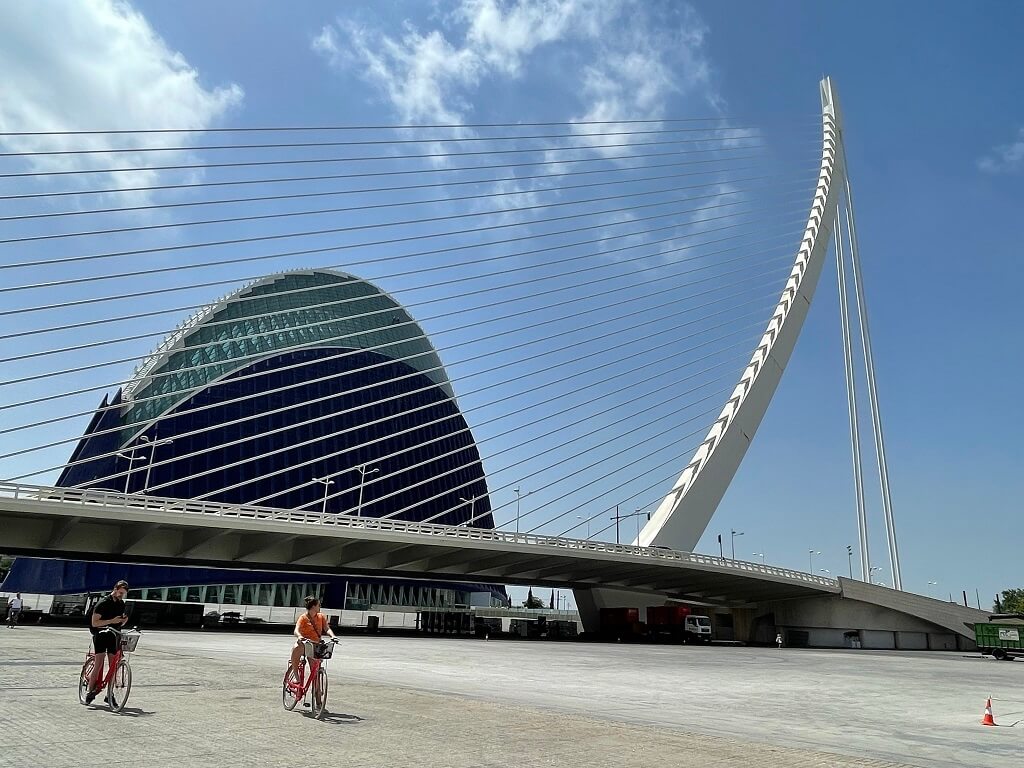
The city offers traffic-free bike lanes and expansive parks to bike your way around the city. Pont L’Assut de L’Or in the background
Buses
The buses in Valencia take you everywhere you want to go, and they are cheap. Just ask your hotel to point out the routes to your destination. We took a 15-minute bus ride from our hotel in the City of Arts and Sciences to Valencia Old Town every day for €1.50 one way.
Metro
Valencia’s subway/metro system is efficient, clean and cheap. Single tickets at €1.50. Get your downloadable map here.
Hop-On-Hop-Off tourist bus
The Hop-On-Hop-Off bus is an excellent way to see the city. Especially on our first day as it will give you a sense of the city’s layout and the location of the Valencia attractions you are most interested in. You can purchase tickets at many hotels, tourism offices and on the bus itself.
How to get to Valencia
By car take V-21 if coming from the north, A-7/V-31 if coming from the south and A-3 and CV-35 if coming from the west. Renting a car in Valencia may be your best option if you’re traveling around the country and want maximum flexibility.
By train, you’ll find Spain has a far-reaching and efficient train system called RENFE. You can purchase your ticket online or at any train station.
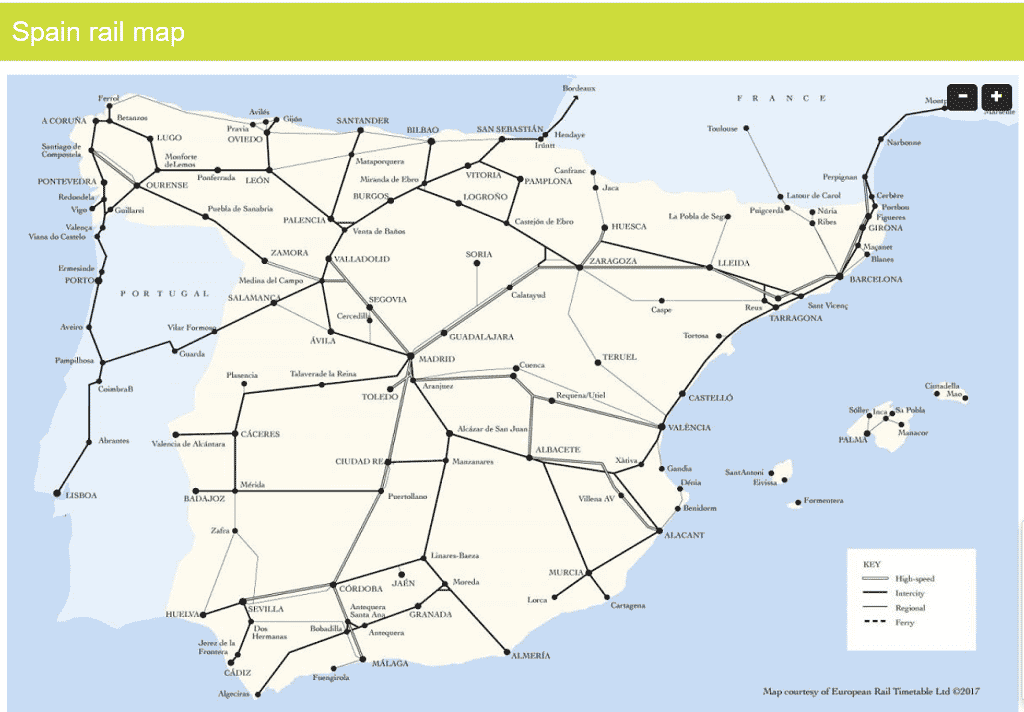
Spain has a wide network of clean and modern buses covering the entire country. Bus stations are concentrated in convenient city locations with easy access to other transportation. Many Spaniards purchase tickets at Movelia.com.
A website people have recommended for travel in Spain is omio.com, sometimes referred to as the “Kayak” of Spain. It is used for train, bus and flights.
How to get to Valencia city center from the airport
Line 5 on the Valencia metro goes from the airport to the center of Valencia regularly. The trip takes 20 minutes and costs about €2. Fernanbús S.A. operates a bus from Valencia Airport to Valencia every 30 minutes. Tickets cost €3 and the journey takes 30 min.
A taxi will cost you about €15 – 20 and takes 10 minutes.
The hop-on-hop-off bus also stops at the local bus station which will go to the airport.
Where to stay in Valencia Old Town
A 2-day Valencia itinerary – City of Arts and Sciences
City of Arts and Sciences- Day 2 of your 2-day Valencia itinerary
The City of Arts and Sciences is an architectural and cultural complex in the city and one of the best museums in Valencia. The project was designed by Santiago Calatrava and Felix Candela. Built on the diverted Turia riverbed, the complex is comprised of a series of museums, aquariums, an opera house, restaurants and other performing arts centers.
Depending on your level of interest in the arts and sciences, you could spend anywhere from a couple of hours to several days exploring this area, one of the 12 Treasures of Spain. Alas! with only a 2-day Valencia itinerary, these are the highlights.
L’Oceanografic
The largest structure of this type in Europe, L’Oceanografic is an aquatic world unto itself. I expected a typical aquarium similar to what exists in many other cities.
What I found was a dolphinarium, shark tanks, incredible collections of over 500 different species from tiny reptiles to beluga whales, plants and many creatures in between…all 45,000 of them!
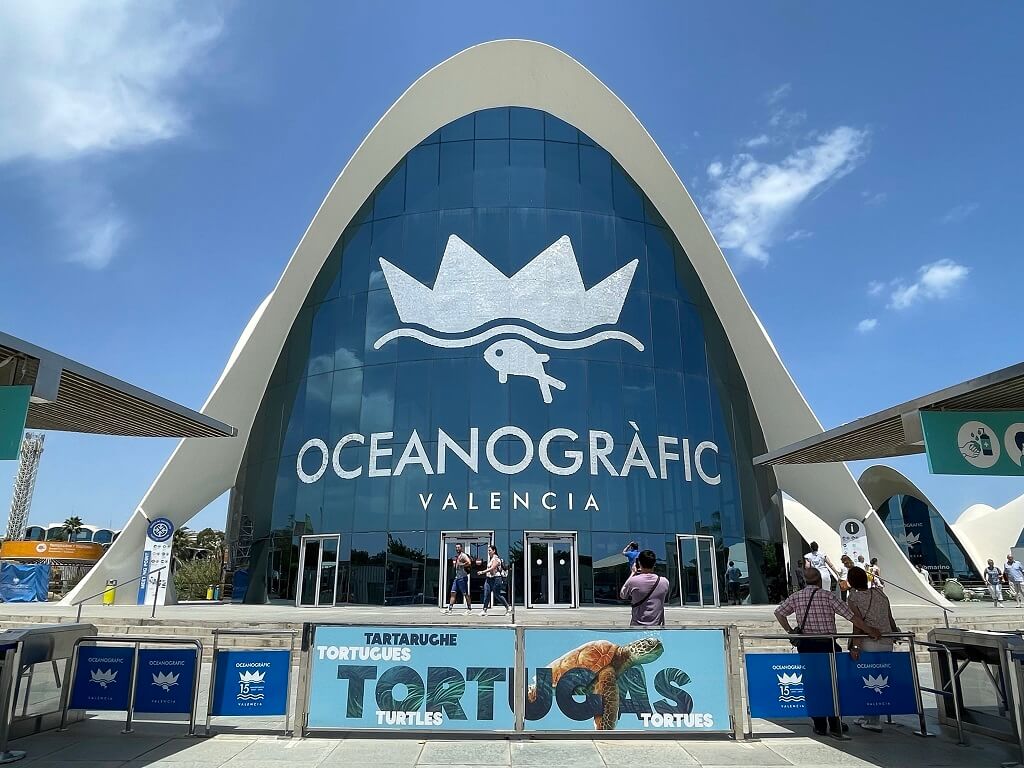
All this amazing flora and fauna live in ten areas, each representing earth’s various habitats: the Mediterranean Sea, the Arctic Oceans, the tropics, the Red Sea and others. It is really quite unique and a must-see during your 2-day Valencia itinerary.
Some of the habitats are reached via underwater tunnels surrounded by denizens of the deep: mantas, multicolored fish and sharks.
Nearby, but not in the actual L’Oceanografic complex, is the Restaurante Submarino, a unique underwater restaurant surrounded by a 360° aquarium. So, you can have lunch or dinner while you are entertained by multicolored fish, manta rays and the occasional shark.
You MUST make a reservation at the restaurant. You don’t have to have a ticket to the L’Oceanografic to dine at the Submarino. As dining experiences go, this is pretty cool.
If you’re pressed for time at the City of Arts and Science but want to add one of these attractions to your 2-day Valencia itinerary, make it the L’Oceanografic.
Palau de les Arts Reina Sofia
The Queen Sofia Palace of Arts is named after Spain’s queen. It is a performing arts center and opera house. Check the schedule to see if you can catch a performance in this unique venue.
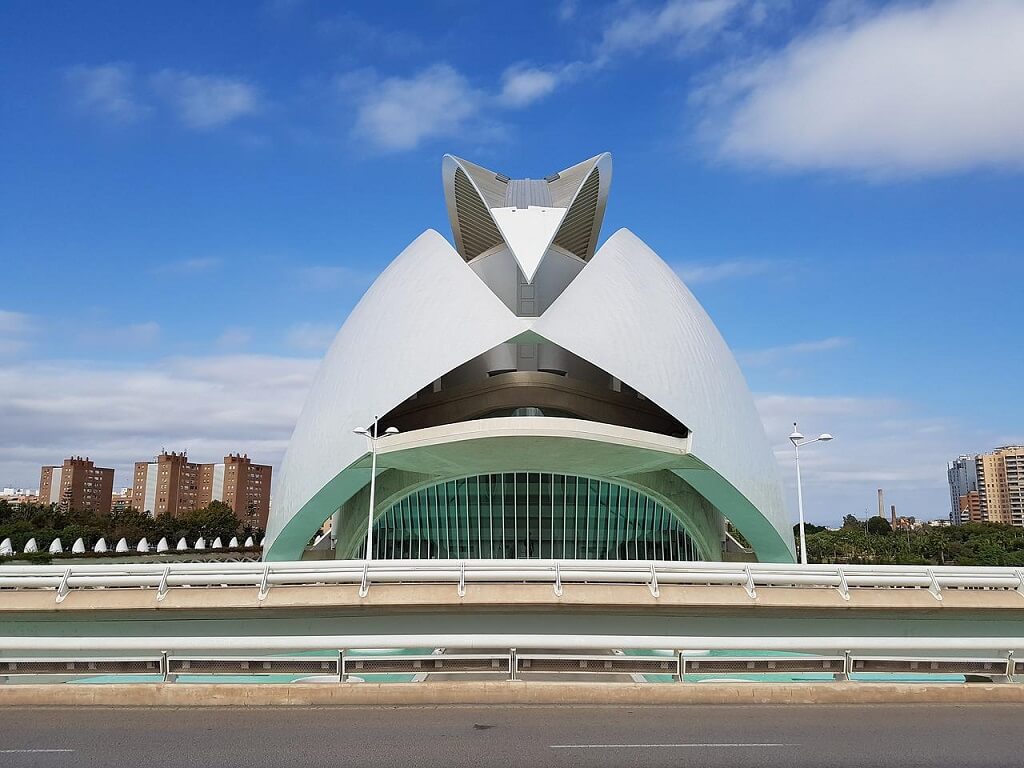
L’Umbracle
L’Umbracle is a sculpture garden showcasing works by renown contemporary artists. The sculptures are displayed in a garden with plant species indigenous to Valencia and the effect is magical.
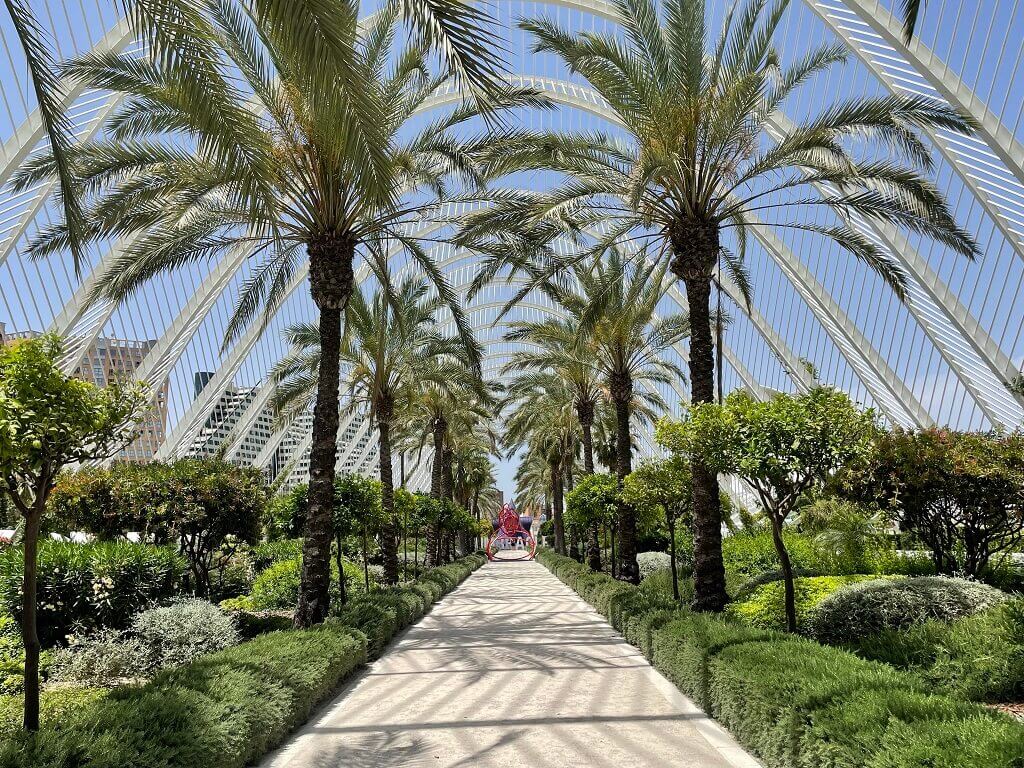
Museu de les Ciencies Principe Felipe
The Prince Philip Science Museum is named after the current king of Spain (when he was still a prince). This interesting museum showcases a regularly rotating eclectic collection of displays like climate change, the human body and spy tradecraft.
Most displays are interactive and hands-on. It’s a fun place for the whole family and a serious learning experience to boot.
L’Hemisferic
L’Hemisferic is an IMAX theater, cinema and planetarium. It was built to resemble a giant eye, the “eye of knowledge” and is a spectacular centerpiece of the City of Arts and Sciences.
There are several theater experiences to choose from including several for kids
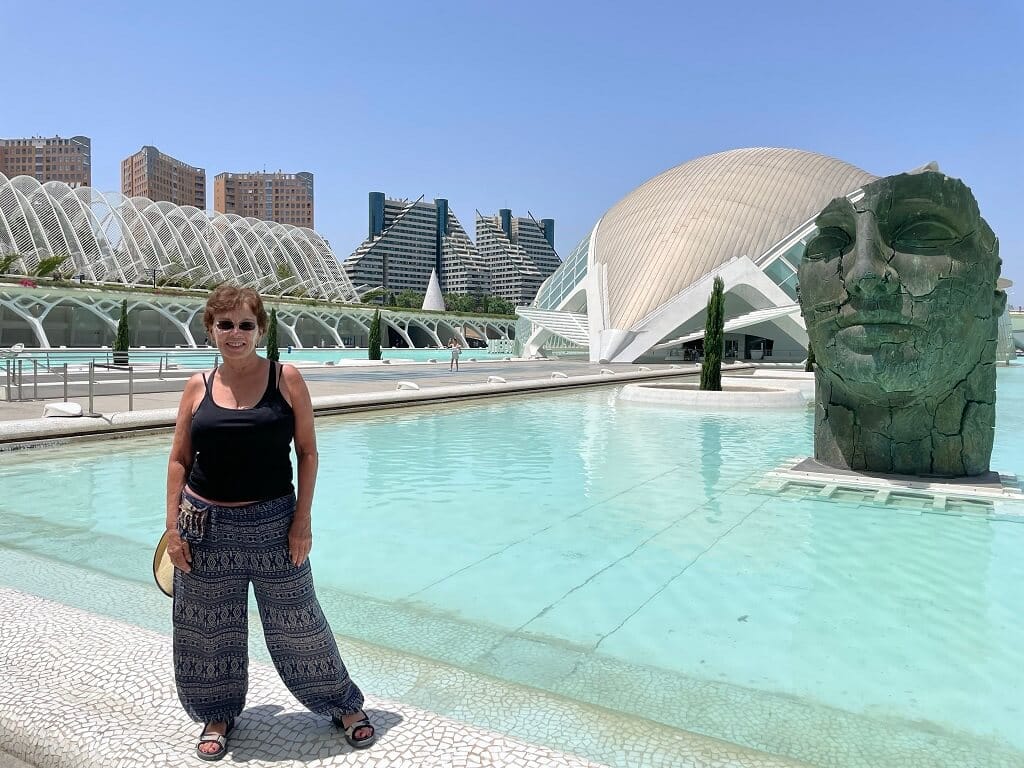
Besides being a remarkable architectural marvel, this structure is beautiful.
Montolivet Bridge
Another one of the little (actually quite large) architectural marvels created by Santiago Calatrava, this bridge lies between L’Hemisferic and the Palau des Arts Reina Sofia and connects the two shores of the Turia River.
Assut de L’Or Bridge
Rather than a destination, the Assut de L’Or Bridge (Dam of Gold in Valencian) is a work of art. The name refers to a nearby dam, but the locals refer to it as El Jamonero, the Ham Holder after a kitchen utensil that secures a ham while it is being sliced, or The Harp. It resembles both. But whatever you call it, it is larger than life and worth visiting.
L’Agora
This is a multifunctional covered space used for events, exhibitions and other purposes. It’s claim to fame is that is an unusual and visually as well as architecturally unique structure. It has a glass roof along its spine and a movable area to control the overhead light.
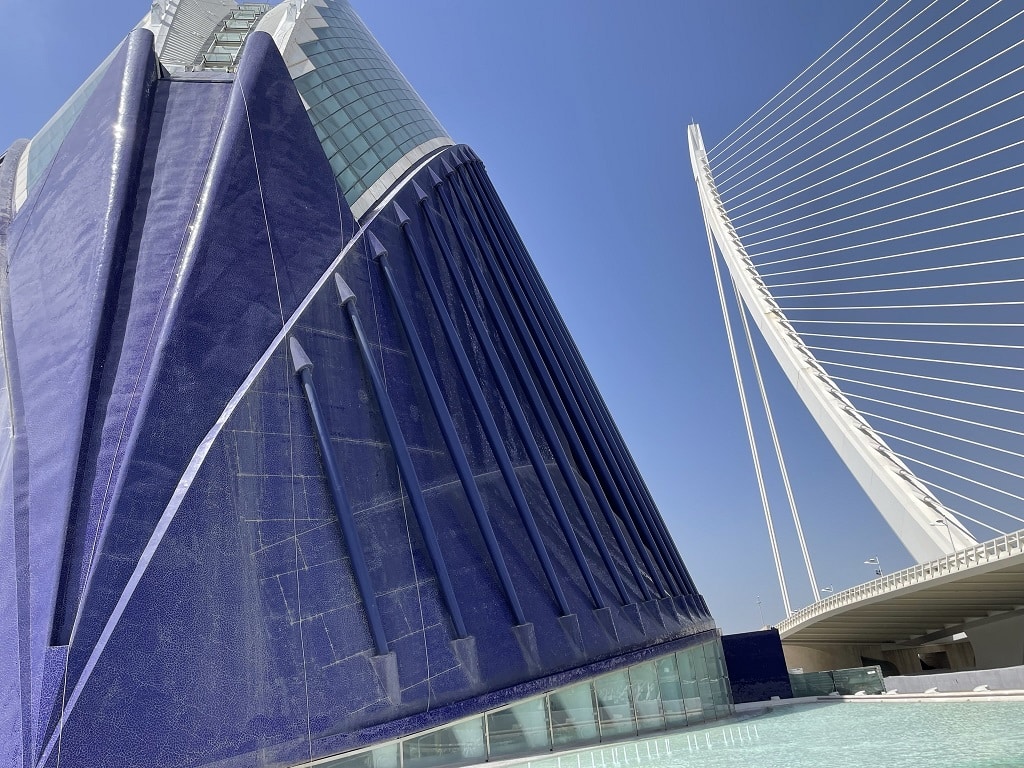
Where to stay in City of Arts and Sciences
Hotels close to the City of Arts and Sciences
Valencia Tip: When you purchase your ticket, you save money by purchasing 3 venues at once; L’Oceanografic, the Princ Felipe science museum and L’Hemisferic rather than purchasing them individually.
What to eat in Valencia and where to eat it on a 2-day Valencia itinerary
Valencia is an underrated foodie city. It has many excellent restaurants around the city and beyond. In the case of Valencia, like in most other cities on Earth, the number one rule for finding a good restaurant applies; look for a restaurant at least 5 blocks away from the major tourist attractions.
You can get perfectly fine meals right near a tourist attraction but, if you’re a foodie looking for the authentic dining experience, step away from the tourists.
Research the restaurants in the city, ask for recommendations (don’t ask locals where you should eat, ask them where THEY eat.)
The specialty in Valencia is the ubiquitous “paella Valenciana.” Invented in Valencia itself, this rice dish is cooked and served in a paella pan. Although we are most familiar with the seafood paella, the traditional paella is made with green beans, fava beans, snails and rabbit. Try and have the traditional dish for a real treat.
Paella is served all over the city and beyond in restaurants called arrocerias (rice places) that also serve other rice dishes.
Some Valencia restaurants I can heartily recommend include:
Casa Montaña. This restaurant has been around since 1836 so they must be doing something right. They are located between the beach and the Old Town. The main menu changes daily based on seasonality and freshness.
Although the specialty is tapas, they also offer much more including a tasting menu, accompanied by wine pairing, that allows you to sample multiple little culinary gems. Hungry yet?
Valencia tip: This is not a place to grab a quick bite and move on. Prepare to spend some time here to savor the experience. Prices are fair for what you get.
Casa Roberto. A lovely atmosphere with impeccable service and delicious food. Casa Roberto is a neighborhood restaurant in one of the city’s more upmarket areas. A tad pricy but worth it for the dining experience.
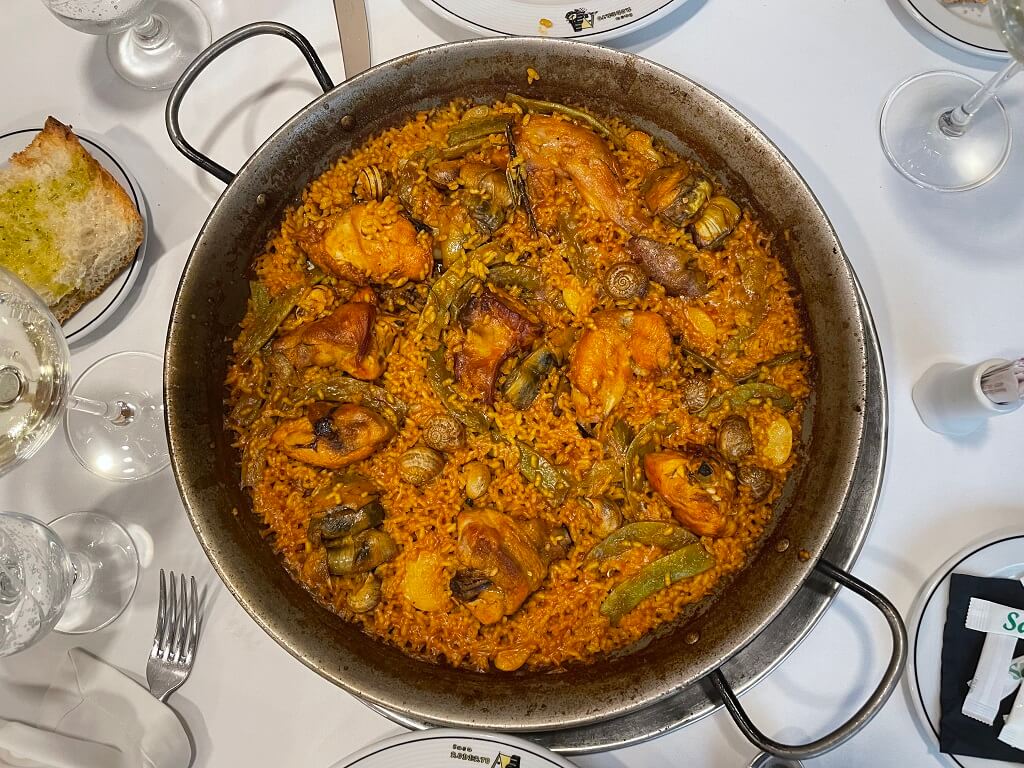
La Pepica offers authentic Valencian fare on a sundrenched terrace in Malvarosso Beach in the Las Arenas area. Las Arenas is one of the stops on the hop-on-hop-off bus. Prices are midrange.
Sagardi. If you’ve had your fill of paella and other rice dishes (tough to do but possible) head over to Sagardi for a delicious sampling of Basque-type tapas and roast meats. This restaurant is in Old Town and easy to walk to from most attractions.
Another Valencia specialty is the Horchata, a thick, chalky, refreshing beverage made from “chufa” or tiger nuts. Horchata is sold everywhere but enjoying it in specialized cafeterias knows as “horchaterias” (horchata places) is a must.
Some horchaterias are famous for being around forever. Among the best known are Horchateria Daniel and Horchateria Santa Catalina, in business for 200 years!
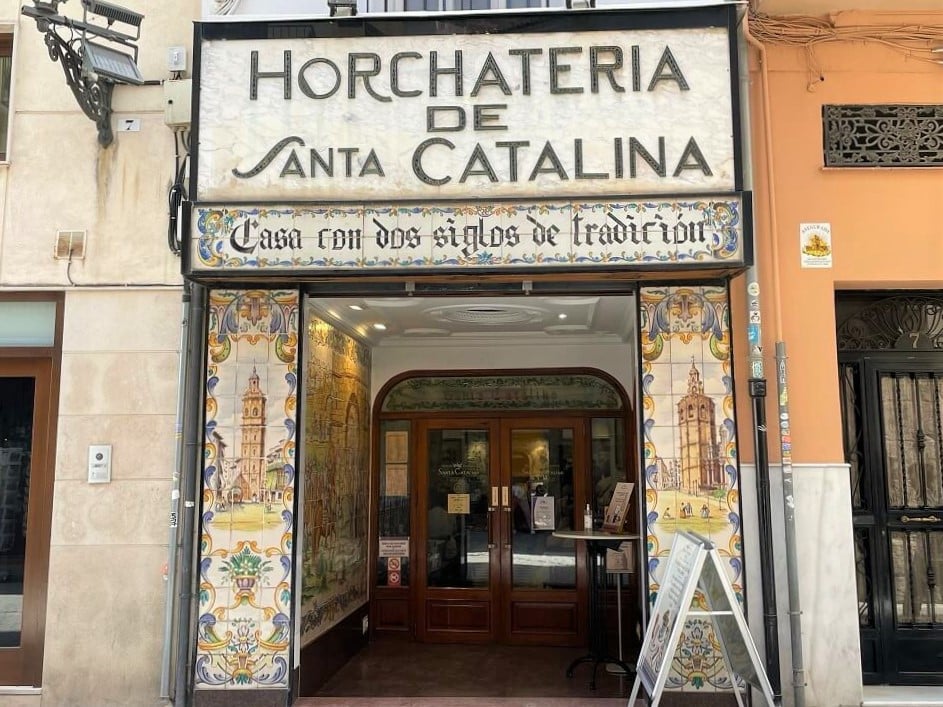
Traditionally horchatas are enjoyed with “fartons” fluffy pastries dusted with sugar. These are dunked in the horchata and wolfed down with a gulp of the delicious beverage.
Finally, the unofficial alcoholic beverage of Valencia is the “agua de Valencia” (Valencia water). This refreshing cocktail is a mix of fresh-squeezed Valencia oranges and cava, vodka or gin. It is an all-day drink enjoyed from breakfast to tapas-hopping evenings.
For an authentic experience, try to include one or more of these Valencia specialties in your 2-day Valencia itinerary.
What does Valencia cost
As European cities go, Valencia is not expensive and offers good value for money. Representative costs include:
- Hotel € 120 +
- Transport € 2
- Airbnb € 60 +
- Entrance fee € 3
- Average meal € 25
- Dining experience € 50 – 100
What’s the best time to visit Valencia?
With 300 sunny days a year, one could argue that it’s always a good time to visit Valencia.
If you want to really nail down the perfect temperature, the fall, with temperatures ranging from a high of 83°F to a low of 47°F, and spring, with temperatures from a high of 76°F to a low of 45°F are the best. The summer heat and crowded tourism season are gone at those times as are the chiller winter weather.
Keep these temperature ranges in mind when planning your 2-day Valencia itinerary.
If you want to visit Valencia during its most important and exciting festival, Las Fallas, plan your Valencia visit in mid-March.
Can’t get enough of Spain? Check out these Spain posts.
EXPLORE THE REGIONAL CUISINE OF SPAIN FOR POPULAR SPANISH FOOD –
HIDDEN GEMS IN SPAIN OFF THE BEATEN PATH –
BEST PLACES TO VISIT IN GALICIA, SPAIN (THAT ARE AFFORDABLE) –
5 INTRIGUING HISTORICAL CASTLES IN SPAIN –
8 EPIC, OFF-THE-BEATEN-TRACK ADVENTURES IN SPAIN THAT WILL TAKE YOUR BREATH AWAY
TOP 16 THINGS TO DO IN GRAN CANARIA, CANARY ISLANDS (SPAIN) –
A 2 WEEK ITINERARY FOR ASTURIAS: NORTHERN SPAIN’S PARADISE
EXPLORING FAMILY HERITAGE IN ASTURIAS, SPAIN –
Don’t forget to stock up on reference material before you visit Valencia. And try your hand at cooking a paella once you’re back home. I tried it and it was a lot of fun to make and specially to eat.
What are your thoughts on this 2-day Valencia itinerary? Let us know in the comments.




















